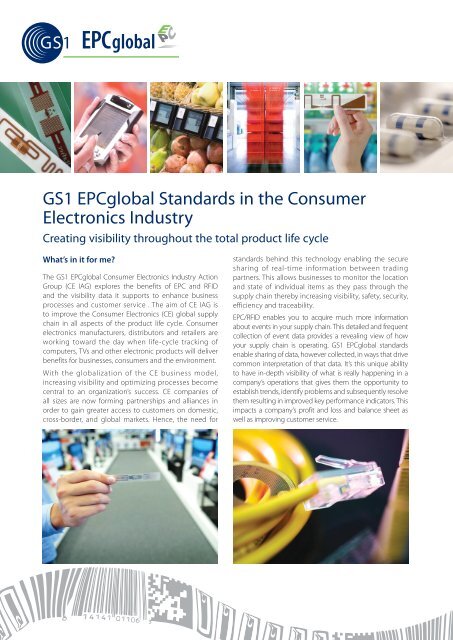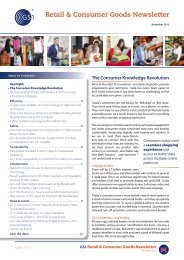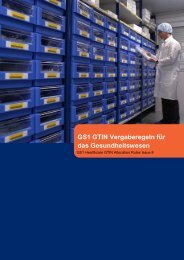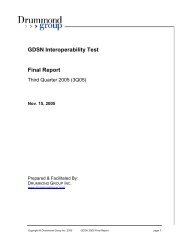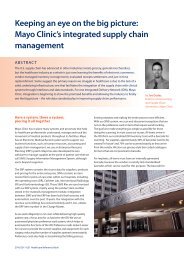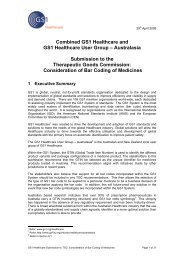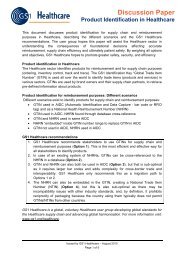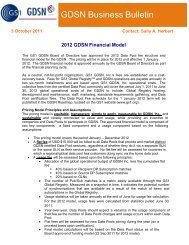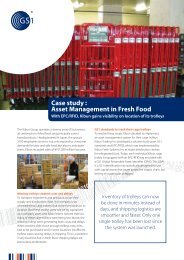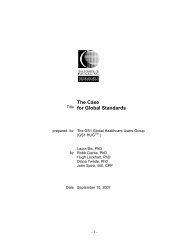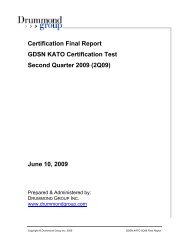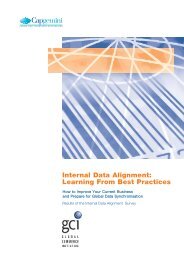GS1 EPCglobal Standards in the Consumer Electronics Industry
GS1 EPCglobal Standards in the Consumer Electronics Industry
GS1 EPCglobal Standards in the Consumer Electronics Industry
You also want an ePaper? Increase the reach of your titles
YUMPU automatically turns print PDFs into web optimized ePapers that Google loves.
<strong>GS1</strong> <strong>EPCglobal</strong> <strong>Standards</strong> <strong>in</strong> <strong>the</strong> <strong>Consumer</strong><br />
<strong>Electronics</strong> <strong>Industry</strong><br />
Creat<strong>in</strong>g visibility throughout <strong>the</strong> total product life cycle<br />
What’s <strong>in</strong> it for me?<br />
The <strong>GS1</strong> <strong>EPCglobal</strong> <strong>Consumer</strong> <strong>Electronics</strong> <strong>Industry</strong> Action<br />
Group (CE IAG) explores <strong>the</strong> benefits of EPC and RFID<br />
and <strong>the</strong> visibility data it supports to enhance bus<strong>in</strong>ess<br />
processes and customer service . The aim of CE IAG is<br />
to improve <strong>the</strong> <strong>Consumer</strong> <strong>Electronics</strong> (CE) global supply<br />
cha<strong>in</strong> <strong>in</strong> all aspects of <strong>the</strong> product life cycle. <strong>Consumer</strong><br />
electronics manufacturers, distributors and retailers are<br />
work<strong>in</strong>g toward <strong>the</strong> day when life-cycle track<strong>in</strong>g of<br />
computers, TVs and o<strong>the</strong>r electronic products will deliver<br />
benefits for bus<strong>in</strong>esses, consumers and <strong>the</strong> environment.<br />
With <strong>the</strong> globalization of <strong>the</strong> CE bus<strong>in</strong>ess model,<br />
<strong>in</strong>creas<strong>in</strong>g visibility and optimiz<strong>in</strong>g processes become<br />
central to an organization’s success. CE companies of<br />
all sizes are now form<strong>in</strong>g partnerships and alliances <strong>in</strong><br />
order to ga<strong>in</strong> greater access to customers on domestic,<br />
cross-border, and global markets. Hence, <strong>the</strong> need for<br />
standards beh<strong>in</strong>d this technology enabl<strong>in</strong>g <strong>the</strong> secure<br />
shar<strong>in</strong>g of real-time <strong>in</strong>formation between trad<strong>in</strong>g<br />
partners. This allows bus<strong>in</strong>esses to monitor <strong>the</strong> location<br />
and state of <strong>in</strong>dividual items as <strong>the</strong>y pass through <strong>the</strong><br />
supply cha<strong>in</strong> <strong>the</strong>reby <strong>in</strong>creas<strong>in</strong>g visibility, safety, security,<br />
efficiency and traceability.<br />
EPC/RFID enables you to acquire much more <strong>in</strong>formation<br />
about events <strong>in</strong> your supply cha<strong>in</strong>. This detailed and frequent<br />
collection of event data provides a reveal<strong>in</strong>g view of how<br />
your supply cha<strong>in</strong> is operat<strong>in</strong>g. <strong>GS1</strong> <strong>EPCglobal</strong> standards<br />
enable shar<strong>in</strong>g of data, however collected, <strong>in</strong> ways that drive<br />
common <strong>in</strong>terpretation of that data. It’s this unique ability<br />
to have <strong>in</strong>-depth visibility of what is really happen<strong>in</strong>g <strong>in</strong> a<br />
company’s operations that gives <strong>the</strong>m <strong>the</strong> opportunity to<br />
establish trends, identify problems and subsequently resolve<br />
<strong>the</strong>m result<strong>in</strong>g <strong>in</strong> improved key performance <strong>in</strong>dicators. This<br />
impacts a company’s profit and loss and balance sheet as<br />
well as improv<strong>in</strong>g customer service.
It’s all about Visibility<br />
Inventory Visibility<br />
• Product Visibility<br />
• Asset Visibility<br />
• Repair, Ma<strong>in</strong>tenance and Recycl<strong>in</strong>g<br />
Brand Protection<br />
• Counterfeit<br />
• Diversion, Gray Market<br />
• Channel Management<br />
Cha<strong>in</strong> of Custody<br />
• Track and Trace<br />
• Electronic Pedigree<br />
Challenges of <strong>the</strong> <strong>Consumer</strong> <strong>Electronics</strong><br />
Supply Cha<strong>in</strong><br />
The <strong>Consumer</strong> <strong>Electronics</strong> Supply Cha<strong>in</strong> faces particular<br />
challenges that EPC-enabled RFID can help address:<br />
• <strong>Consumer</strong> <strong>Electronics</strong> items tend to be of a high<br />
average value, are used for longer periods, <strong>in</strong> some cases<br />
more than 10 years and require more secure handl<strong>in</strong>g <strong>in</strong><br />
<strong>the</strong> supply cha<strong>in</strong>. Therefore, tags and applications must<br />
be reliable and susta<strong>in</strong>able.<br />
• A smooth passage through total product life cycle is<br />
essential for cost competitiveness and customer service<br />
as CE supply cha<strong>in</strong>s can be geographically dispersed<br />
with a high ratio of goods manufactured <strong>in</strong> Asia <strong>the</strong>n<br />
shipped <strong>in</strong>to markets all over <strong>the</strong> world.<br />
• After <strong>the</strong>y are sold, CE items may be repaired and/<br />
or ma<strong>in</strong>ta<strong>in</strong>ed by manufacturers or services providers<br />
dur<strong>in</strong>g usage. This means that product <strong>in</strong>formation<br />
needs to be accessible not only by manufacturers but<br />
by o<strong>the</strong>r supply cha<strong>in</strong> partners such as retailers, service<br />
providers and recycle companies. As a result, str<strong>in</strong>gent<br />
security specifications for tags and systems are required.<br />
• Most CE products must be tagged and monitored at item<br />
level <strong>in</strong> order to ensure better services at <strong>the</strong> po<strong>in</strong>t of sale<br />
as well as improved repair and ma<strong>in</strong>tenance services. This<br />
means that item level tagg<strong>in</strong>g on each product is necessary<br />
while ensur<strong>in</strong>g that consumer privacy is protected.<br />
Benefits of EPC/RFID Technology <strong>in</strong> <strong>the</strong><br />
<strong>Consumer</strong> <strong>Electronics</strong> Supply Cha<strong>in</strong><br />
• Bus<strong>in</strong>ess:<br />
RFID tags on products will enable lifecycle management<br />
of consumer electronics and provide traceability from <strong>the</strong><br />
procurement of parts and components to manufactur<strong>in</strong>g,<br />
distribution, sales, servic<strong>in</strong>g and ma<strong>in</strong>tenance, and recycl<strong>in</strong>g.<br />
This will ensure that consumer electronics products are<br />
dependable, safe, and easy on <strong>the</strong> environment.<br />
Visibility enables traceability of products<br />
Visibility enables traceability and au<strong>the</strong>ntication<br />
of products<br />
Visibility supplies <strong>the</strong> custody <strong>in</strong>formation for<br />
creat<strong>in</strong>g au<strong>the</strong>nticated cha<strong>in</strong> of custody<br />
RFID, EPC and <strong>the</strong> support<strong>in</strong>g data exchange standards<br />
will facilitate collaboration among CE supply cha<strong>in</strong><br />
partners lead<strong>in</strong>g to a reduction <strong>in</strong> <strong>the</strong> complexity of <strong>the</strong>ir<br />
global supply cha<strong>in</strong>s, higher profitability and improved<br />
productivity.<br />
Fur<strong>the</strong>r advantages, as item-level tagg<strong>in</strong>g becomes a<br />
reality for <strong>the</strong> CE Supply cha<strong>in</strong>, <strong>in</strong>clude improved product<br />
recall capacity, product au<strong>the</strong>ntication, and aid<strong>in</strong>g <strong>in</strong><br />
<strong>the</strong> efficient adm<strong>in</strong>istration of consumer guarantees.<br />
EPC/RFID technology will also significantly reduce <strong>the</strong><br />
widespread problem of counterfeit products which<br />
is estimated to cost over $500 billion annually. More<br />
specifically, <strong>in</strong> <strong>the</strong> European Union alone, <strong>the</strong> number<br />
of registered cases of counterfeit products <strong>in</strong>creased by<br />
400% over <strong>the</strong> last 5 years.<br />
• After Sales Services:<br />
<strong>Consumer</strong>s are placed to enjoy a number of immediate<br />
advantages from EPC-enabled <strong>Consumer</strong> Electronic<br />
products <strong>in</strong> <strong>the</strong> form of improved product availability<br />
and greater reliability <strong>in</strong> terms of quality, safety and<br />
supply cha<strong>in</strong> security.<br />
By <strong>in</strong>tegrat<strong>in</strong>g a product serial number at Item Level<br />
<strong>in</strong>to <strong>the</strong> EPC encoded <strong>in</strong>to an RFID tag, improvement<br />
of after sales services will be achieved, ensur<strong>in</strong>g a<br />
much more efficient service experience for customers.<br />
Product returns, compla<strong>in</strong>ts and warranty services can<br />
be done without today’s required paper receipt. An<br />
RFID tag attached to or embedded <strong>in</strong> <strong>the</strong> product acts<br />
as a lifelong sales slip and makes conservation of paper<br />
receipts obsolete. A unique and quick identification of<br />
<strong>the</strong> returned item will reduce wait<strong>in</strong>g times and improve<br />
<strong>the</strong> customer service quality significantly.<br />
By attach<strong>in</strong>g RFID tags conta<strong>in</strong><strong>in</strong>g EPCs on products,<br />
<strong>the</strong> operators responsible for repair<strong>in</strong>g defective<br />
products can easily obta<strong>in</strong> repair and ma<strong>in</strong>tenance<br />
records, <strong>in</strong>voice <strong>the</strong> appropriate party, and rewrite<br />
warranty <strong>in</strong>formation accurately.
When problems occur with CE products after many<br />
years of use, respond<strong>in</strong>g quickly requires much time and<br />
energy. RFID tags conta<strong>in</strong><strong>in</strong>g EPCs on products will make<br />
it possible to handle such problems <strong>in</strong> a timely manner.<br />
Most warranty validation today is done at <strong>the</strong> item and<br />
not <strong>the</strong> component level. If a tag of sufficient capacity<br />
is used <strong>the</strong>n <strong>the</strong> extended user memory can be used to<br />
record key warranty related data such as date and place<br />
of sale. This too can ensure that <strong>the</strong> malfunction<strong>in</strong>g<br />
component with<strong>in</strong> <strong>the</strong> item is <strong>the</strong> one that was built <strong>in</strong>to<br />
it at <strong>the</strong> time of manufacture and not one substituted<br />
from ano<strong>the</strong>r item that is no longer under warranty.<br />
• Environment:<br />
Hav<strong>in</strong>g RFID-enabled CE products will help reduce <strong>the</strong><br />
amount of waste that pollutes <strong>the</strong> environment, s<strong>in</strong>ce<br />
only defective components ra<strong>the</strong>r than whole products<br />
are discarded.<br />
The costs of collect<strong>in</strong>g and sort<strong>in</strong>g used consumer<br />
electronics are high. Some countries require manufacturers<br />
to take back and recycle <strong>the</strong> products <strong>the</strong>y sell (or pay for<br />
<strong>the</strong>ir take-back and recycl<strong>in</strong>g) when consumers are ready to<br />
dispose of <strong>the</strong>m. Today’s end of life service providers have<br />
to identify and separate <strong>the</strong> different recycle streams for CE<br />
products manually or with expensive sensors. EPC-enabled<br />
EOL processes will aid supply cha<strong>in</strong> partners when <strong>the</strong> time<br />
comes to collect and sort used consumer electronics.<br />
When products are to be discarded, RFID tags will help<br />
achieve efficient recycl<strong>in</strong>g. Referr<strong>in</strong>g to detailed product<br />
<strong>in</strong>formation on <strong>the</strong> tags enables proper handl<strong>in</strong>g of<br />
hazardous materials, collection of valuable rare metals,<br />
and <strong>the</strong> recycl<strong>in</strong>g of parts and components. RFID tags<br />
will provide <strong>the</strong> proof of proper handl<strong>in</strong>g by recycl<strong>in</strong>g<br />
operators, which will assure environmental protection.<br />
Eventually, RFID tags could even help ensure that<br />
manufacturers comply with regulatory mandates for<br />
disposal of toxic substances (many electronic products<br />
conta<strong>in</strong> lead, mercury and o<strong>the</strong>r hazardous substances).<br />
CE Global Supply Cha<strong>in</strong> Partners<br />
Total product life cycle management takes a global approach to<br />
supply cha<strong>in</strong> processes. EPC enabled RFID can help drive bus<strong>in</strong>ess<br />
operations efficiencies for multiple supply cha<strong>in</strong> partners:<br />
• <strong>Consumer</strong> <strong>Electronics</strong> Manufacturer:<br />
Receiv<strong>in</strong>g and <strong>in</strong>ventory management of raw materials<br />
and components, packag<strong>in</strong>g materials, manufactur<strong>in</strong>g,<br />
commission<strong>in</strong>g, aggregat<strong>in</strong>g items to pallet, f<strong>in</strong>ished product<br />
<strong>in</strong>ventory management, plant localization, order pick<strong>in</strong>g,<br />
shipp<strong>in</strong>g, transportation, after-sales services, efficient product<br />
recall processes <strong>in</strong> terms of defective product.<br />
• Logistics Providers:<br />
Receiv<strong>in</strong>g and product <strong>in</strong>ventory management, aggregate<br />
pallets to conta<strong>in</strong>er, consolidation/deconsolidation, order<br />
pick<strong>in</strong>g, track<strong>in</strong>g, shipp<strong>in</strong>g, distribution.<br />
• Retailers:<br />
Receiv<strong>in</strong>g of pallets and products, <strong>in</strong>spect<strong>in</strong>g products,<br />
<strong>in</strong>ventory management, order pick<strong>in</strong>g, sell<strong>in</strong>g of product,<br />
adm<strong>in</strong>istration and traceability of products. convenience<br />
by supply<strong>in</strong>g product related <strong>in</strong>formation, anti-<strong>the</strong>ft<br />
management and after-sales services.<br />
• End of Life Process Providers:<br />
Receiv<strong>in</strong>g of products, <strong>in</strong>ventory management, recycl<strong>in</strong>g,<br />
ultimate disposal, order pick<strong>in</strong>g, distribution, adm<strong>in</strong>istration<br />
and traceability of products.<br />
About <strong>GS1</strong> <strong>EPCglobal</strong> <strong>Standards</strong> and<br />
<strong>EPCglobal</strong> Inc<br />
<strong>GS1</strong> <strong>EPCglobal</strong> <strong>Standards</strong> are a set of <strong>in</strong>tegrated <strong>in</strong>dustrydriven<br />
standards which have been developed to meet<br />
user requirements enabl<strong>in</strong>g <strong>the</strong> identification of objects,<br />
data capture and shar<strong>in</strong>g of <strong>in</strong>formation among partners<br />
throughout <strong>the</strong> supply cha<strong>in</strong>. These standards are<br />
developed with<strong>in</strong> <strong>the</strong> framework of <strong>EPCglobal</strong> Inc.
<strong>EPCglobal</strong> Inc is a subsidiary of <strong>the</strong> global not-for-profit<br />
standards organization <strong>GS1</strong>, and supports <strong>the</strong> global<br />
adoption of <strong>the</strong> Electronic Product Code as <strong>in</strong>dustry-driven<br />
standards to enable accurate, immediate and cost-effective<br />
visibility of <strong>in</strong>formation throughout <strong>the</strong> supply cha<strong>in</strong>.<br />
About <strong>the</strong> <strong>GS1</strong> <strong>EPCglobal</strong> <strong>Consumer</strong><br />
<strong>Electronics</strong> <strong>Industry</strong> Action Group<br />
• Mission and Goal:<br />
The <strong>Consumer</strong> <strong>Electronics</strong> <strong>Industry</strong> Action Group is one<br />
of an expand<strong>in</strong>g number of <strong>in</strong>dustry focused global RFID<br />
standards groups developed under <strong>the</strong> <strong>GS1</strong> <strong>EPCglobal</strong><br />
standards framework. The <strong>GS1</strong> <strong>EPCglobal</strong> <strong>Standards</strong><br />
Development Process is critical to ensur<strong>in</strong>g that <strong>the</strong> standards<br />
developed and ratified by <strong>the</strong> <strong>EPCglobal</strong> Board of Governors<br />
are user driven, global and royalty-free wherever possible.<br />
The objectives of <strong>the</strong> CE IAG are to develop RFID enabled<br />
bus<strong>in</strong>ess processes through <strong>the</strong> utilization of EPC to improve<br />
<strong>the</strong> <strong>Consumer</strong> <strong>Electronics</strong> supply cha<strong>in</strong> <strong>in</strong> all aspects of <strong>the</strong><br />
product life cycle.<br />
Additionally, <strong>the</strong> group aims to improve <strong>the</strong> repair operation<br />
process to ensure better customer satisfaction. <strong>Consumer</strong><br />
<strong>Electronics</strong> organizations <strong>in</strong>volved <strong>in</strong> <strong>the</strong> CE IAG will ga<strong>in</strong> <strong>the</strong><br />
benefits of standardized EPC enabled bus<strong>in</strong>ess processes <strong>in</strong><br />
<strong>the</strong>ir global multi-partner supply cha<strong>in</strong>s.<br />
• Target audiences<br />
The CE IAG is target<strong>in</strong>g supply cha<strong>in</strong> partners with an<br />
<strong>in</strong>terest <strong>in</strong> adopt<strong>in</strong>g RFID enabled bus<strong>in</strong>ess processes <strong>in</strong> <strong>the</strong><br />
<strong>Consumer</strong> <strong>Electronics</strong> supply cha<strong>in</strong>; consumer electronic<br />
manufactur<strong>in</strong>g companies, distributors, wholesalers, retailers,<br />
providers of end of life processes as well as CE <strong>in</strong>dustry<br />
associations, solution providers and service providers such as<br />
test centres and certification organisations.<br />
• Our relevance<br />
The <strong>Consumer</strong> <strong>Electronics</strong> <strong>in</strong>dustry faces many challenges <strong>in</strong><br />
today’s global economy. The CE IAG has identified examples<br />
where EPC/RFID enables competitive advantages thanks to<br />
supply cha<strong>in</strong> visibility and efficiency by reduc<strong>in</strong>g out of stocks,<br />
reduc<strong>in</strong>g <strong>the</strong>ft and diversion, and <strong>in</strong>creas<strong>in</strong>g factor utilization<br />
and productivity. Improved visibility enhances asset<br />
management, and supports a broad range of safe and secure<br />
<strong>in</strong>itiatives such as anti-counterfeit, supply management, and<br />
traceability to ensure products are dependable, safe and easy<br />
on <strong>the</strong> environment.<br />
The CE IAG has described high-level bus<strong>in</strong>ess scenarios<br />
and <strong>the</strong>ir associated use cases <strong>in</strong> order to identify and drive<br />
bus<strong>in</strong>ess requirements <strong>in</strong> <strong>the</strong> context of <strong>GS1</strong> <strong>EPCglobal</strong><br />
standards concern<strong>in</strong>g Identification, Data Capture and Data<br />
Exchange. By describ<strong>in</strong>g high priority use cases from a global<br />
perspective, <strong>the</strong> CE IAG will derive <strong>the</strong> maximum possible<br />
benefit from <strong>the</strong> implementation of EPC/RFID.<br />
• Why Sony and HP are lead<strong>in</strong>g <strong>the</strong> CE IAG <strong>in</strong>itiative<br />
“RFID technology based upon <strong>GS1</strong> <strong>EPCglobal</strong> standards enables<br />
accurate, immediate and cost effective visibility of <strong>in</strong>formation<br />
throughout <strong>the</strong> life cycle of <strong>Consumer</strong> <strong>Electronics</strong> products,<br />
ga<strong>in</strong>ed through our participation <strong>in</strong> <strong>EPCglobal</strong> CE IAG activities.<br />
It is beneficial not only for manufacturers like us, but also for<br />
o<strong>the</strong>r supply cha<strong>in</strong> players such as; distributors, logistic service<br />
providers, and recycle operators. The most important th<strong>in</strong>g is<br />
however, our customers are set to benefit too”.<br />
Tatsuya Yoshimura<br />
Co-Chair <strong>EPCglobal</strong> CE IAG<br />
RFID <strong>Standards</strong> Research and Promotion Manager<br />
Sony Corporation<br />
“With <strong>the</strong> globalization of bus<strong>in</strong>ess, optimiz<strong>in</strong>g processes<br />
becomes central to an organization’s success. EPC/RFID<br />
technology, based upon <strong>GS1</strong> <strong>EPCglobal</strong> standards, enables our<br />
company to maximize efficiency by solv<strong>in</strong>g problems with<strong>in</strong> <strong>the</strong><br />
supply cha<strong>in</strong> and reduc<strong>in</strong>g operational complexity at facilities<br />
around <strong>the</strong> world which also allows us to help our customers.<br />
Hence, our commitment to play a lead<strong>in</strong>g role <strong>in</strong> <strong>the</strong> CE IAG,<br />
a platform of different stakeholders who are keen to solve <strong>the</strong><br />
current and future challenges <strong>in</strong> <strong>the</strong> <strong>Consumer</strong> <strong>Electronics</strong><br />
supply cha<strong>in</strong>.”<br />
Greg Edds<br />
Co-Chair <strong>EPCglobal</strong> CE IAG<br />
Worldwide RFID Program Lead<br />
Hewlett-Packard Company<br />
How to Jo<strong>in</strong> <strong>the</strong> <strong>GS1</strong> <strong>EPCglobal</strong> Community<br />
To f<strong>in</strong>d out more about <strong>the</strong> <strong>GS1</strong> <strong>EPCglobal</strong> community,<br />
<strong>in</strong>clud<strong>in</strong>g becom<strong>in</strong>g a subscriber, and to participate actively <strong>in</strong><br />
<strong>the</strong> development and implementation of global standards to<br />
create visibility and improve efficiency throughout <strong>the</strong> supply<br />
cha<strong>in</strong>, please visit http://www.epcglobal<strong>in</strong>c.org/home.<br />
<strong>Consumer</strong> <strong>Electronics</strong> companies are more than welcome<br />
to jo<strong>in</strong> <strong>the</strong> activities of <strong>the</strong> <strong>EPCglobal</strong> <strong>Consumer</strong> <strong>Electronics</strong><br />
<strong>Industry</strong> Action Group. In order to participate <strong>in</strong> this group as<br />
well as <strong>the</strong> <strong>GS1</strong> <strong>EPCglobal</strong> <strong>Standards</strong> Development Process, it<br />
is mandatory to become an <strong>EPCglobal</strong> subscriber.<br />
For more <strong>in</strong>formation regard<strong>in</strong>g <strong>the</strong> <strong>EPCglobal</strong> <strong>Consumer</strong><br />
<strong>Electronics</strong> <strong>Industry</strong> Action Group, contact Audrey<br />
Kremer at audrey.kremer@gs1.org or your local <strong>GS1</strong><br />
Member Organization (contact details are available on<br />
www.epcglobal<strong>in</strong>c.org).


